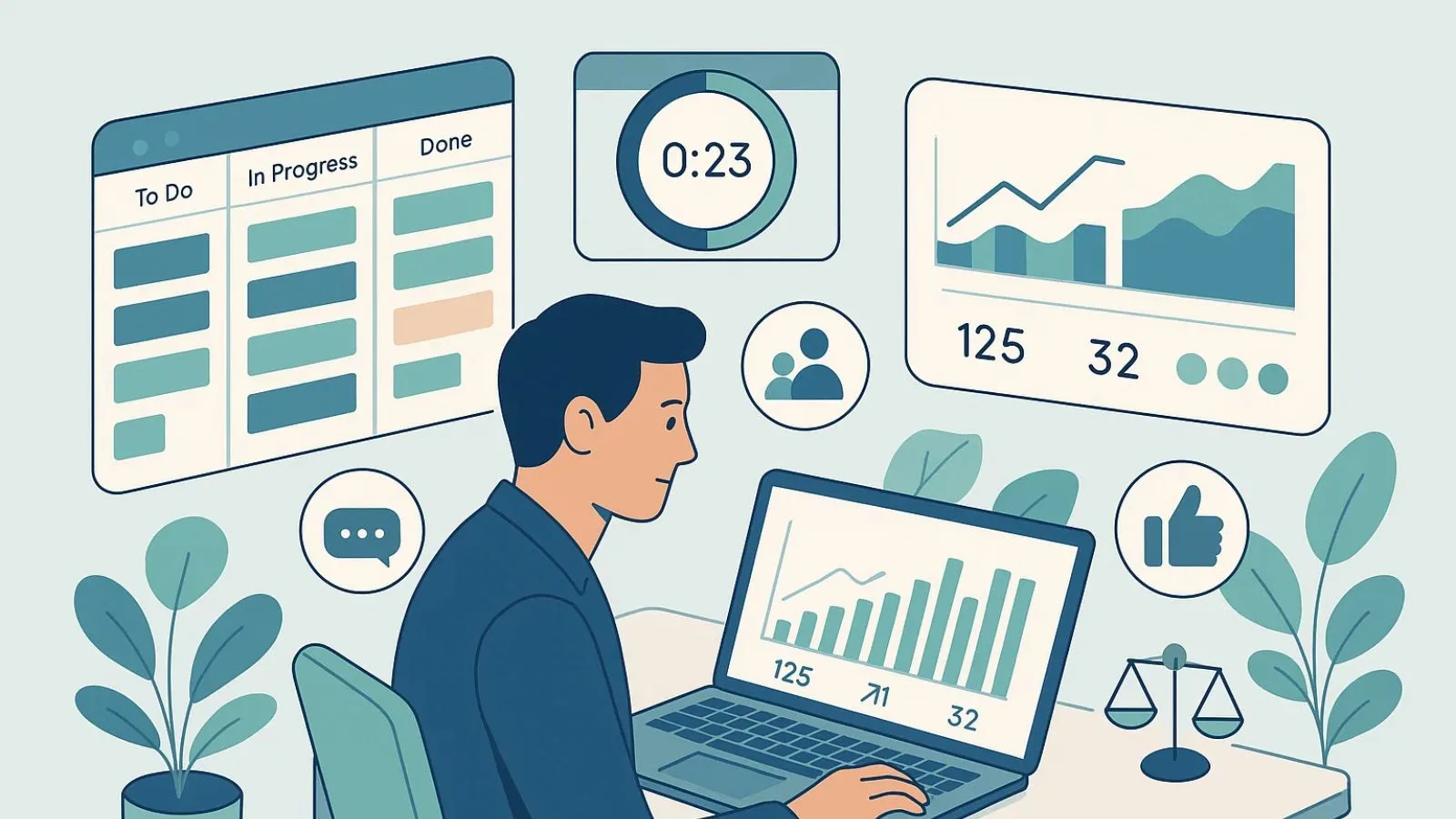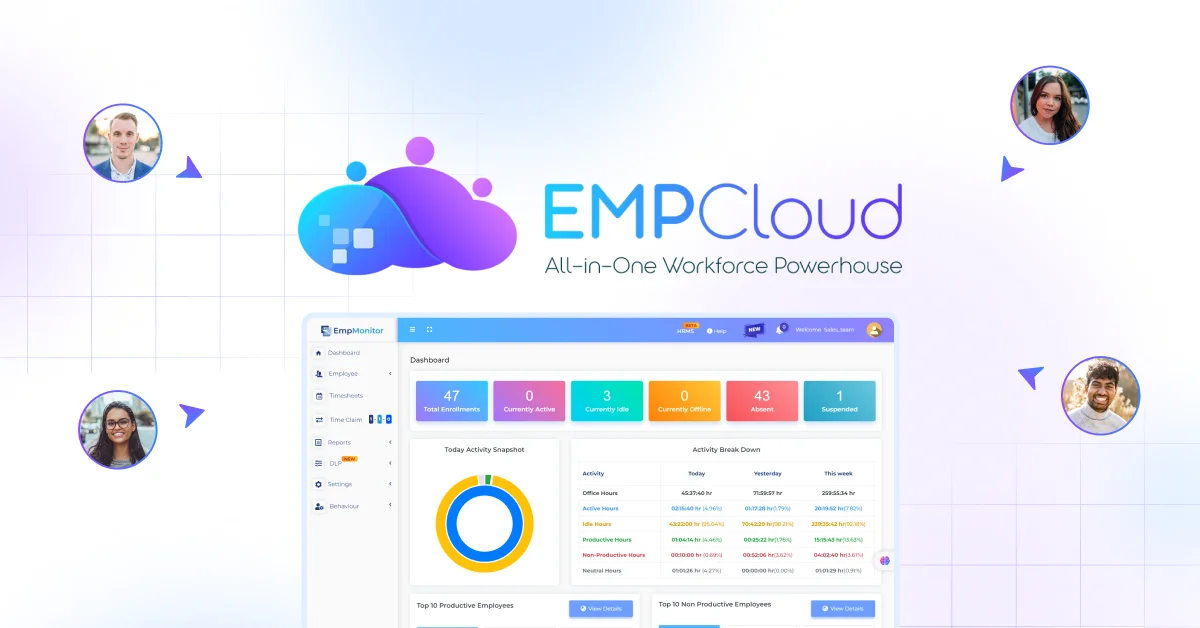
Remote work has revolutionized how teams operate, providing flexibility and expanding talent pools for businesses worldwide. However, as organizations embrace this shift, managing remote employees has become a critical challenge. How can managers track productivity without losing their team’s trust? Implementing remote employee monitoring is the answer, but doing so without micromanaging requires strategy, tools, and thoughtful leadership.
Listen To The Podcast Now!
Understanding the Need for Remote Employee Monitoring:
The idea of remote employee monitoring is often met with skepticism. Some managers fear it will turn into surveillance, while employees worry about losing autonomy. However, monitoring isn’t about control; it’s about accountability.
Studies show that 61% of remote workers feel productive at home, but 27% still struggle with time management issues. This gap is where monitoring tools can make a difference.
Beyond just tracking time, remote employee monitoring ensures that employees remain aligned with company goals, securely handle sensitive information, and collaborate effectively.
The remote work landscape presents unique challenges that didn’t exist in traditional office environments. Communication barriers, time zone differences, and the absence of physical oversight can create gaps in workflow visibility.
These challenges don’t stem from a lack of trust but from the inherent nature of distributed teams. With the right approach, monitoring can foster accountability while enhancing team morale and productivity.
To truly succeed, organizations must go beyond tracking performance and focus on how to Build A Flexible Work Environment that empowers employees while maintaining transparency and trust.
It provides managers with the insights needed to offer timely support, recognize achievements, and identify when team members might be overwhelmed or disengaged.
Rather than creating a culture of surveillance, thoughtful monitoring establishes a foundation for meaningful conversations about work-life balance, professional development, and team success.
Why Remote Employee Monitoring Matters?
The success of remote employee monitoring hinges on understanding its purpose.
Rather than viewing it as a tool for surveillance, consider it a mechanism for improving transparency and organizational health. For example, tracking progress toward deadlines can highlight potential bottlenecks early.
Tools such as remote employee monitoring software can automate reporting, enabling managers to gain real-time insights into workflows without relying on constant manual check-ins.
Additionally, monitoring helps in identifying trends, such as peak productive hours for different employees, enabling managers to optimize schedules and workflows.
Remote employee monitoring also plays a crucial role in maintaining security and compliance. When teams work from various locations, often on personal networks, the risk of data breaches increases significantly.
Monitoring tools can alert managers to unusual activity patterns, unauthorized access attempts, or potential security vulnerabilities before they become serious problems.
Furthermore, monitoring creates an objective record of work patterns that can inform strategic decisions.
Whether it’s determining optimal team sizes, identifying training needs, or allocating resources effectively, data-driven insights replace guesswork with actionable intelligence.
This benefits both the organization and employees, as decisions become more equitable and based on actual performance rather than proximity bias or subjective impressions.
The Psychology Behind Effective Remote Monitoring:
Understanding the human element is essential when implementing any monitoring system.
Employees are not machines; they’re individuals with varying work styles, personal circumstances, and psychological needs. The way monitoring is framed and implemented can either empower or demoralize your team.
Research in organizational psychology shows that autonomy is one of the strongest predictors of job satisfaction and performance.
When employees feel trusted and given the freedom to manage their own time and methods, they’re more engaged and productive.
Conversely, excessive monitoring triggers stress responses, reduces creativity, and can lead to burnout.
The key is to design monitoring systems that acknowledge this reality. Instead of creating an environment where employees feel constantly watched, establish systems that provide support and visibility.
Frame monitoring is a tool that helps employees succeed rather than one that catches them failing.
When team members understand that monitoring data is used to identify obstacles they’re facing and provide resources they need, resistance transforms into acceptance.
Additionally, involve employees in the conversation about monitoring from the start. Solicit their input on what metrics matter most, what tools feel least invasive, and how monitoring data should be used.
This participatory approach not only yields better systems but also builds the trust necessary for monitoring to work without creating resentment.
Striking the Right Balance:
Any discussion about remote employee monitoring must address the potential risks of misuse.
Micromanagement can stifle creativity, lower morale, and ultimately erode trust between teams and leadership. Instead of focusing solely on what employees are doing, aim to build a culture of transparency and mutual trust.
Incorporate tools like employee remote work monitoring software that focus on outcomes rather than invasive tracking.
For instance, project management dashboards can show task progress without revealing every keystroke or website visited. In this way, monitoring becomes less about “watching” and more about enabling success.
The balance also involves recognizing when not to monitor. Some aspects of work require deep focus, creative thinking, or research that may not produce immediate visible output.
Effective monitoring systems account for these realities, allowing for periods of apparent inactivity that are actually productive thinking time.
Similarly, respecting boundaries around personal time, even when employees are working from home, is crucial for maintaining healthy work-life integration.
Implementing Remote Employee Monitoring Without Micromanaging:
The key to implementing remote employee monitoring without micromanaging lies in clarity, purpose, and communication. Here are actionable steps every organization can follow:
1. Set Clear Expectations
From the outset, define what success looks like. This includes defining deadlines, deliverables, and Key Performance Indicators (KPIs). When goals are aligned and communicated, monitoring tools can focus on results rather than actions.
Create detailed job descriptions and project briefs that outline expected outcomes, quality standards, and timelines. Ensure every team member understands not just what they need to do, but why it matters and how it contributes to larger organizational objectives. This context transforms monitoring from oversight into shared accountability toward meaningful goals.
2. Choose the Right Tools:
Not all tools are created equal. Opt for options that emphasize accountability and outcomes. For instance, the best remote employee monitoring systems often include productivity analytics, customizable reporting, and optional manual tracking for sensitive tasks.
Evaluate tools based on their flexibility and respect for employee privacy. Look for features like activity summaries rather than real-time surveillance, aggregate reporting rather than individual keystroke logging, and customizable visibility settings that let teams adjust monitoring levels based on trust and necessity. The technology should serve your culture, not dictate it.
3. Promote Transparency:
Be open about what you’re monitoring and why. Inform teams that tools are there to support them, not to scrutinize them. Encourage a feedback loop where employees can voice concerns about the tools you’re using. Transparency also means sharing the data collected.
When employees can see their own metrics and understand how they’re being evaluated, monitoring becomes a tool for self-improvement rather than external judgment. Regular reviews where monitoring data is discussed openly can turn potentially adversarial information into collaborative problem-solving opportunities.
4. Focus on Outcomes Over Activity:
Instead of tracking every minute spent on a project, look at deliverables and deadlines. Use remote monitoring tools to gauge team progress rather than individual clock-in times. This outcome-based approach recognizes that different people work in different ways. Some employees may complete tasks quickly with intense focus, while others may need longer periods with more breaks.
What matters is the quality and timeliness of the final product, not the specific path taken to get there. This flexibility not only reduces micromanagement but also accommodates diverse working styles and neurodiverse team members.
5. Create Regular Checkpoints:
Periodic one-on-one meetings or team reviews can replace incessant monitoring. Provide a forum for employees to voice concerns and establish mutual trust through constructive dialogue. These checkpoints should be structured conversations that go beyond status updates. Use them to discuss challenges, celebrate wins, provide coaching, and adjust expectations as needed. When managers regularly connect with their teams in meaningful ways, the need for constant monitoring diminishes because trust and communication fill that gap.
6. Establish Clear Boundaries:
Define what will be monitored and what remains private. Make it clear that monitoring occurs only during work hours and doesn’t extend to personal devices or activities.
Respect for boundaries demonstrates that the organization values employees as whole people, not just as workers.
Additionally, create escalation protocols for when monitoring reveals concerning patterns. Employees should know that if monitoring indicates struggles, the first response will be a supportive conversation, not punitive action.
This approach encourages honesty and help-seeking rather than hiding problems until they become crises.
Best Tools and Practices:
Implementing effective monitoring requires an understanding of both the tools and the workplace culture. Here are some tools and practices to consider:
1. Project Management Dashboards:
Platforms like Asana, Trello, or Monday.com provide transparency into workflow and progress, which can serve as part of monitoring remote employee activity without micromanaging.
These visual tools allow everyone to see project status, upcoming deadlines, and team workload at a glance, creating shared accountability without feeling invasive.
2. Time Tracking with Boundaries:
Use software like Toggl or Clockify to track time spent on tasks, but avoid micromanaging by emphasizing agreed-upon goals over idle hours.
Time tracking should serve as a resource planning tool and help employees understand their own productivity patterns, not as a weapon to criticize efficiency.
3. Activity Summaries Instead of Raw Data:
Monitoring doesn’t need to drown managers in details. Tools like employee remote monitoring software can summarize daily or weekly activities, offering a high-level view of productivity trends.
These summaries provide enough information for informed decision-making without the overwhelming detail that encourages micromanagement.
4. Feedback Systems:
Utilize systems like Lattice or 15Five, which focus on continuous feedback and employee well-being alongside productivity tracking.
These platforms integrate monitoring with employee development, ensuring that performance data drives growth conversations rather than punitive measures.
Also Read:
How EmpCloud Enhances Remote Employee Monitoring?
In this digital workspace, balancing monitoring with flexibility can be challenging. This is where EmpCloud shines. Unlike traditional monitoring tools that focus on tracking every activity,
EmpCloud leverages AI to provide intelligent, outcome-based insights. For instance, its Activity Summary tool gives managers an overview of employee progress without requiring constant check-ins.
Teams can choose their preferred level of visibility, balancing security with autonomy. This transparency builds trust, making employees feel respected rather than micromanaged. Additionally, EmpCloud supports remote employee monitoring software that proactively identifies problems.
Imagine detecting whether a team member is frequently missing deadlines or struggles with workload balance, enabling managers to address potential issues before they escalate.
All this is wrapped in a secure framework, ensuring sensitive client data remains protected. The true power of EmpCloud lies in fostering a supportive and balanced workplace environment.
By streamlining monitoring into manageable, actionable insights, it aligns teams towards common goals without sacrificing trust.
With features like instant notifications and customizable reports, EmpCloud offers the best remote employee monitoring system for organizations that prioritize balance, accountability, and growth.
Investing in tools like EmpCloud transforms remote employee monitoring from a source of tension to a facilitator of excellence.
It reinforces the idea that productivity and trust can coexist, making it a must-have for any remote team eager to thrive in the era of distributed work.
Conclusion:
Remote employee monitoring isn’t about mistrusting employees; it’s about building systems that keep teams aligned and productive.
The goal is to find the balance between the guidance managers need and the autonomy employees deserve.
With the right tools, like what EmpCloud offers, and the right mindset, businesses can embrace remote monitoring as a tool for growth rather than control.
The future of work depends on this delicate balance, and those who strike it will lead.
FAQ’s:
Q1: What is Remote Employee Monitoring?
Ans: It involves tracking employee activities to ensure productivity and accountability. Done correctly, it’s not surveillance but a framework to support team success.
Q2: How Can I Prevent Micromanaging While Monitoring?
Ans: Focus on outcomes, use tools that emphasize productivity, and set clear communication about the purpose of monitoring.
Q3: Are These Tools Legally Compliant?
Ans: Ensure tools comply with labor laws and local regulations on privacy. Transparency with employees is crucial to staying compliant.









